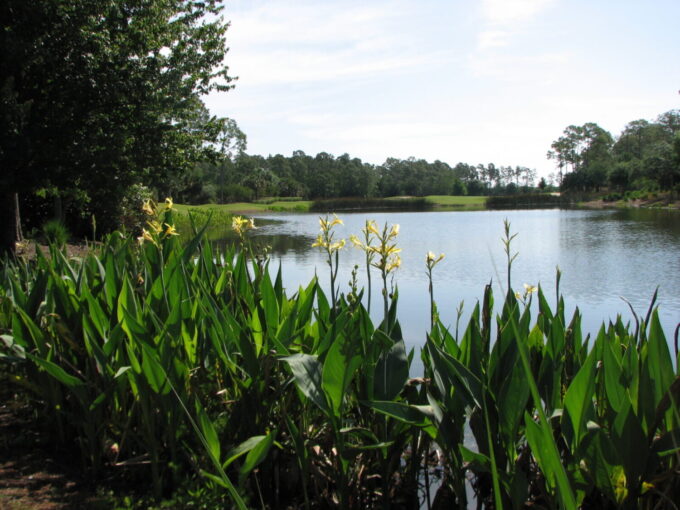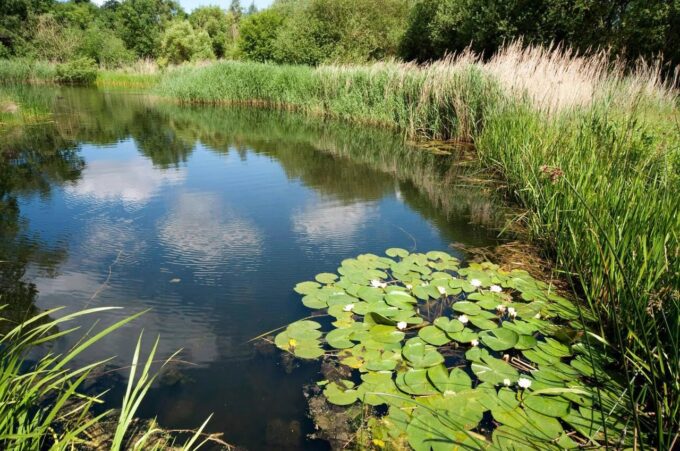Key Takeaways:
- Creating and maintaining a wildlife pond enhances the beauty of your landscape and provides a valuable habitat.
- Choose a sunny spot away from overhanging trees and ensure a good source of water.
- Construct the pond with various depths and incorporate native plants for different habitats.
- Attract wildlife by creating suitable breeding areas, providing cover, and adding perches or vantage points.
- Manage water quality by monitoring parameters and managing algae and weed growth.
- Promote biodiversity by understanding trophic levels, attracting beneficial predators, and controlling invasive species.
1. Creating and Maintaining a Wildlife Pond

Source: ntlabs.co.uk
Creating and wildlife pond management is a rewarding endeavor that not only enhances the beauty of your landscape but also provides a valuable habitat for a wide range of species. Whether you have a large estate or a small backyard, a wildlife pond can be established and managed to attract a diverse array of wildlife.
1.1 Choosing the Right Location
The first step in creating a wildlife pond is selecting the right location. Ideally, a sunny spot away from overhanging trees is preferred, as shade can promote excessive algae growth. Additionally, it’s important to ensure that the chosen area has a good source of water, either through a natural spring, rainwater collection system, or a mains water supply.
Consider the surrounding landscape as well. A pond situated near natural habitats like woodlands or meadows can attract a greater variety of wildlife. It’s also essential to check with local authorities or land agencies for any guidelines or permits required for pond construction in your area.
1.2 Constructing the Pond
Once the location has been decided, the next step is to construct the pond. First, mark out the shape and size of the pond using a hosepipe or rope. Dig the hole, making sure to include sloping sides and different depths to cater to a variety of organisms.
Consider incorporating features such as shallow shelves, which provide areas for emergent plants and nesting birds, as well as deeper sections to accommodate aquatic plants and animals. It’s important to remember that the depth of the pond should vary to provide different habitats for wildlife.
Line the pond with a layer of underlay and then a pond liner to prevent water seepage. Secure the liner in place and carefully place rocks or logs around the edges to create a natural appearance. Finally, fill the pond with water using rainwater if possible, as tap water may contain chlorine or other chemicals that can harm wildlife.
1.3 Selecting Native Plants for the Pond
Native aquatic plants play a crucial role in wildlife pond ecosystems. They provide food and shelter for various species, help to filter the water, and contribute to oxygen levels. When selecting plants for your wildlife pond, choose native species that are adapted to your area’s climate and water conditions.
Consider including a mix of submerged, floating, and emergent plants to cater to the different needs of aquatic species. Submerged plants such as hornwort and waterweed provide oxygen and shelter for small invertebrates and fish. Floating plants like water lilies provide cover and food for amphibians and insects. Emergent plants such as sedges and rushes offer nesting sites for birds and provide a transition zone between the water and land.
It’s important to source native plants from reputable suppliers to avoid introducing invasive species that can disrupt the balance of the ecosystem.
2. Attracting Wildlife to Your Pond

Source: tampabaypond.com
Once your wildlife pond is established, the next step is to attract a variety of wildlife to make it their home. By creating suitable habitats and providing the necessary resources, you can entice a range of aquatic and terrestrial species to visit and thrive in your pond ecosystem.
2.1 Welcoming Aquatic Animals
To attract aquatic animals such as frogs, newts, and dragonflies to your pond, ensure that there are suitable areas for them to breed and lay eggs. Create shallow areas with gentle slopes or add lily pads and other floating plants for animals to rest and breed on.
Consider introducing some native fish species like minnows or sticklebacks, which not only add visual interest but also play a part in balancing the ecosystem by controlling mosquito larvae and other pests.
Provide hiding places like submerged logs or rocks that offer shelter and protection for the wildlife. These features provide a safe haven for small fish and invertebrates, attracting larger predatory species like herons and kingfishers.
2.2 Luring Birds and Amphibians
Birds and amphibians are attracted to ponds for various reasons, including breeding, feeding, and drinking. To entice them to your wildlife pond, ensure that there is a range of vegetation around the pond that offers cover and nesting sites.
Plant shrubs, grasses, and wildflowers near the pond to provide habitat for birds and amphibians. Include native plants that produce berries or seeds, attracting a variety of birds for both food and shelter.
Provide perches such as tree branches or posts near the pond, which act as vantage points for birds to spot prey in the water.
2.3 Encouraging Reptiles and Insects
Reptiles such as turtles and snakes, as well as insects like dragonflies and damselflies, can greatly benefit from a well-designed wildlife pond. To encourage these species to your pond, incorporate hibernation areas and basking spots.
Leave a shallow area or pile of rocks at the edge of the pond where reptiles can sunbathe and warm themselves. These areas are essential for maintaining reptile body temperature and can also attract insects for food.
Include a variety of native flowering plants around the pond to attract pollinators like bees and butterflies. These insects play a vital role in the ecosystem by facilitating the reproduction of plants and providing a food source for other organisms.
3. Managing Water Quality and Nutrient Balance

Source: solitudelakemanagement.com
Proper management of water quality and nutrient balance is essential for the overall health and sustainability of your wildlife pond ecosystem. By carefully monitoring and regulating these factors, you can create a balanced environment that supports a wide range of wildlife.
3.1 Monitoring Water Parameters
Regular monitoring of water parameters is crucial to maintaining a healthy wildlife pond. Test the pH, ammonia, nitrate, and nitrite levels regularly to ensure they are within the optimal range for aquatic life.
Changes in water parameters can indicate issues such as pollution, excessive organic matter, or imbalance in the ecosystem. Address any abnormal readings promptly to prevent potential harm to the wildlife.
3.2 Managing Algae and Weed Growth
While some algae and aquatic plants are beneficial to the pond ecosystem, excessive growth can be problematic. Algae blooms can deplete oxygen levels and negatively impact other organisms.
To manage algae and weed growth, manually remove excess vegetation, being careful not to disturb any wildlife. Use pond tools like rakes or nets to skim the surface and remove debris.
Consider introducing bottom-dwelling species like snails or mussels, which can help control algae growth by consuming excess nutrients.
3.3 Balancing Nutrient Levels
Proper nutrient balance is essential for the health of your wildlife pond. Excess nutrients can lead to excessive algal growth and poor water quality.
Avoid overfeeding fish or introducing excessive organic matter that can decompose and release nutrients into the water. Minimize the use of fertilizers near the pond, as runoff can contribute to nutrient imbalance.
Planting native vegetation around the pond can help absorb excess nutrients, improving water quality and reducing the risk of algae blooms.
4. Supporting Biodiversity and Ecosystem Balance

Source: studyprobe.in
Supporting biodiversity and maintaining a balanced ecosystem is the key to a successful wildlife pond. By understanding the food webs and trophic relationships within the pond, promoting beneficial predators, and controlling invasive species, you can create a thriving and harmonious wildlife habitat.
4.1 Understanding Food Webs and Trophic Levels
A wildlife pond consists of various trophic levels, with different organisms occupying each level. Understanding the food webs and interactions between these organisms is crucial to maintaining balance.
At the bottom of the food web, microscopic algae and plants convert sunlight into energy through photosynthesis. These primary producers are then consumed by herbivorous invertebrates, which in turn provide food for larger organisms such as fish and amphibians.
Predatory animals like birds, reptiles, and mammals occupy higher trophic levels, feeding on smaller prey. By supporting a diverse range of species at different trophic levels, you can promote a stable ecological balance in your wildlife pond.
4.2 Promoting Beneficial Predators
Beneficial predators play an essential role in controlling populations of pests like mosquitoes and algae-consuming organisms. By attracting and promoting the presence of these predators, you can maintain a healthy and well-balanced ecosystem.
Encourage the presence of birds like swallows and martins, which feed on flying insects like mosquitoes. Install nest boxes or shelters to support their breeding and help attract these beneficial birds to your pond.
Amphibians such as frogs and toads are also valuable predators of small invertebrates and can help control populations of pests in your wildlife pond. Provide hiding places and overwintering sites for amphibians to encourage their presence.
4.3 Controlling Invasive Species
Invasive species can quickly disrupt the balance of a wildlife pond ecosystem. They often outcompete native plants and animals for resources, leading to a decline in biodiversity.
Regularly inspect your pond for signs of invasive species and take appropriate action to control their spread. Remove any invasive plants manually, ensuring that all roots and seeds are disposed of properly to prevent regrowth.
If invasive animals like non-native fish or crayfish are present, consult with local experts or wildlife agencies to determine the most effective and environmentally friendly methods of removal.
By actively managing invasive species, you can help protect the native biodiversity and preserve the ecological balance of your wildlife pond.
In conclusion, creating and maintaining a wildlife pond requires careful planning and ongoing management. By choosing the right location, constructing the pond correctly, selecting native plants, and attracting a variety of wildlife, you can establish a thriving ecosystem that enhances biodiversity and promotes ecosystem balance. Regular monitoring of water quality and nutrient levels, as well as understanding the food webs and trophic relationships, is crucial for the long-term success of your wildlife pond. By promoting beneficial predators and controlling invasive species, you can ensure a harmonious and sustainable habitat for a diverse range of wildlife.







